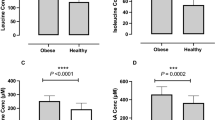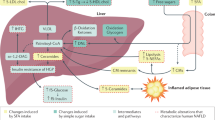Abstract
Background/Objectives:
Dietary addition of either conjugated linoleic acid (CLA) or n-3 long-chain polyunsaturated fatty acids (n-3 LC-PUFAs) has been shown to alter adiposity and circulating lipids, risk markers of cardiovascular diseases. However, CLA may decrease insulin sensitivity, an effect that may be reversed by n-3 LC-PUFA. Thus, the potential of CLA plus n-3 LC-PUFA to affect insulin secretion and sensitivity in non-diabetic young and old, lean and obese subjects was tested.
Subjects/Methods:
CLA (3 g daily) plus n-3 LC-PUFA (3 g daily) or control oil (6 g daily) was given to lean (n=12; BMI 20–26 kg/m2) or obese (n=10; BMI 29–35 kg/m2) young (20–37 years old) or lean (n=16) or obese (n=11) older men (50–65 years) for 12 weeks. The study had a double-blind, placebo-controlled randomized crossover design, and primary end points were insulin secretion and sensitivity during a standardized meal test, evaluated by modeling glucose, insulin and C-peptide data.
Results:
The combination was well tolerated. There was no significant difference in fasting levels of glucose, insulin or C-peptide after CLA/n-3 LC-PUFA treatment compared with control oil. Neither insulin secretion nor estimated sensitivity was affected by CLA/n-3 LC-PUFA in lean or obese young subjects or in older lean subjects. However, in older obese subjects, estimated insulin sensitivity was reduced with CLA/n-3 LC-PUFA compared with control (P=0.024).
Conclusions:
The results do not support beneficial effects of CLA/n-3 LC-PUFA for β-cell dysfunction or insulin resistance in humans but suggest that insulin sensitivity in older obese subjects is reduced.
This is a preview of subscription content, access via your institution
Access options
Subscribe to this journal
Receive 12 print issues and online access
$259.00 per year
only $21.58 per issue
Buy this article
- Purchase on Springer Link
- Instant access to full article PDF
Prices may be subject to local taxes which are calculated during checkout


Similar content being viewed by others
References
Ahrén B, Pacini G (2004). Importance of quantifying insulin secretion in relation to insulin sensitivity to accurately assess beta cell function in clinical studies. Eur J Endocrinol 150, 97–104.
Al-Hasani H, Joost HG (2005). Nutrition-/diet induced changes in gene expression in white adipose tissue. Best Pract Res Clin Endocrinol Metab 19, 584–603.
Balk EM, Lichtenstein AH, Chung M, Kupelnick B, Chew P, Lau J (2006). Effects of omega-3 fatty acids on serum markers of cardiovascular disease risk. Atherosclerosis 189, 19–30.
Blankson H, Stakkestad JA, Fagertun H, Thom E, Wadstein J, Gudmundsen O (2000). Conjugated linoleic acid reduces body fat in overweight and obese subjects. J Nutr 130, 2943–2948.
Bruss ML, Black AL (1978). Enzymatic microdetermination of glycogen. Anal Biochem 84, 309–312.
Chung S, Brown JM, Provo JN, Hopkins R, McIntosh MK (2005). Conjugated linoleic acid promotes human adipocycte insulin resistance through NFkappaB-dependent cytokine production. J Biol Chem 280, 38445–38456.
DeLany JP, West DB (2000). Changes in body composition with conjugated linoleic acid. J Am Coll Nutr 19, 487–493.
Delarue J, Li CH, Cohen R, Corporeau C, Simon B (2006). Interaction of fish oil and a glucocorticoid on metabolic responses to an oral glucose load in healthy human subjects. Br J Nutr 95, 267–272.
Despres JP, Lemieux I (2006). Abdominal obesity and metabolic syndrome. Nature 444, 881–887.
Farmer A, Montori V, Dinneen S, Clar C (2000). Fish oil in people with type 2 diabetes mellitus. Diabetes Care 23, 1407–1415.
Ferrannini E, Camastra S, Gastaldelli A, Sironi AM, Natali A, Muscelli E et al. (2004). Beta-cell function in obesity: effects of weight loss. Diabetes 53 (Suppl 3), S26–S33.
Hamura M, Yamatoya H, Kudo S (2001). Glycerides rich in conjugated linoleic acid (CLA) improve blood glucose control in diabetic C57BLKS-Leprdb/leprdb mice. J Oleo Sci 50, 889–894.
Henderson L, Gregory J, Irving K, Swan G (2003). The National Diet and Nutrition Survey: Adults Aged 19–64 years, Volume 2: Energy, Protein, Carbohydrate, Fat and Alcohol Intake. HMSO: London.
Houseknecht K, Vanden Heuvel JP, Moya-Camarena SY, Portocarrero CP, Peck LW, Nickel KP et al. (1998). Dietary conjugated linoleic acid normalizes impaired glucose tolerance in Zucker diabetic fatty fa/fa rat. Biochem Biophys Res Commun 244, 678–682.
Ide T (2005). Interaction of fish oil and conjugated linoleic acid in affecting hepatic activity of lipogenic enzymes and gene expression in liver and adipose tissue. Diabetes 54, 412–423.
Ikemoto S, Takahashi M, Tsunoda N, Maruyama K, Itakura H, Ezaki O (1996). High-fat diet-induced hyperglycemia and obesity in mice: differential effects of dietary oils. Metabolism 45, 1539–1546.
Kahn SE (2003). The relative contributions of insulin resistance and beta-cell dysfunction to the pathophysiology of type 2 diabetes. Diabetologia 46, 3–19.
Kahn SE, Hull RL, Utzschneider KM (2006). Mechanisms linking obesity to insulin resistance and type 2 diabetes. Nature 444, 840–846.
Larsen TM, Toubro S, Astrup A (2003). Efficacy and safety of dietary supplements containing conjugated linoleic acid (CLA) for the treatment of obesity—evidence from animal and human studies. J Lipid Res 44, 2234–2241.
Lombardo YB, Chicco AG (2006). Effects of dietary polyunsaturated n-3 fatty acids on dyslipidemia and insulin resistance in rodents and humans. J Nutr Biochem 17, 1–13.
Mari A, Gastaldelli A, Foley JE, Pratley RE, Ferrannini E (2005a). β-cell function in mild type 2 diabetic patients. Effects of 6-month glucose lowering with nateglinide. Diabetes Care 28, 1132–1138.
Mari A, Pacini G, Brazzale AR, Ahrén B (2005b). Comparative evaluation of simple insulin sensitivity methods based on the oral glucose tolerance test. Diabetologia 48, 748–751.
Mari A, Pacini G, Murphy E, Ludvik B, Nolan JJ (2001). A model-based method for assessing insulin sensitivity from the oral glucose tolerance test. Diabetes Care 24, 539–548.
Mari A, Schmitz O, Gastaldelli A, Oestergaard T, Nyholm B, Ferrannini E (2002a). Meal and oral glucose tests for the assessment of β-cell function: modeling analysis in normal subjects. Am J Physiol 283, E1159–E1166.
Mari A, Tura A, Gastaldelli A, Ferrannini E (2002b). Assessing insulin secretion by modeling in multiple-meal tests: role of potentiation. Diabetes 51, S221–S226.
Moloney F, Toomey S, Noone E, Nugent A, Allan B, Loscher CE et al. (2007). Antidiabetic effects of cis-9, trans-11-conjugated linoleic acid may be mediated via anti-inflammatory effects in white adipose tissue. Diabetes 56, 574–578.
Moloney F, Yeow TP, Mullen A, Nolan JJ, Roche HM (2004). Conjugated linoleic acid supplementation, insulin sensitivity, and lipoprotein metabolism in patients with type 2 diabetes mellitus. Am J Clin Nutr 80, 887–895.
Park Y, Albright KL, Liu W, Storkson JM, Cook ME, Pariza MW (1997). Effect of conjugated linoleic acid on body composition in mice. Lipids 32, 853–858.
Poirier H, Niot I, Clement L, Guerre-Millo M, Besnard P (2005). Development of conjugated linoleic acid (CLA)-mediated lipoatrophic syndrome in the mouse. Biochimie 87, 73–89.
Poirier H, Shapiro JS, Kim RJ, Lazar MA (2006). Nutritional supplementation with trans-10, cis-12-conjugated linoleic acid induces inflammation of white adiposetissue. Diabetes 55, 1634–1641.
Risérus U, Arner P, Brismar K, Vessby B (2002). Treatment with dietary trans10cis12 conjugated linoleic acid causes isomer-specific insulin resistance in obese men with the metabolic syndrome. Diabetes Care 25, 1516–1521.
Riserus U, Vessby B, Arnlov J, Basu S (2004). Effects of cis-9, trans-11 conjugated linoleic acid supplementation on insulin sensitivity, lipid peroxidation, and proinflammatory markers in obese men. Am J Clin Nutr 80, 279–283.
Roche HM, Noone E, Sewter C, Mc Bennett S, Savage D, Gibney MJ et al. (2002). Isomer dependent metabolic effects of conjugated linoleic acid (CLA): insights from molecular markers: SREBP-1c and LXRα. Diabetes 51, 2037–2044.
Ruxton C (2004). Health benefits of omega-3 fatty acids. Nurs Stand 18, 38–42.
Ruzickova J, Rossmeisi M, Prazak T, Flachs P, Sponarova J, Veck M et al. (2004). Omega-3 PUFA of marine origin limit diet-induced obesity in mice by reducing cellularity of adipose tissue. Lipids 39, 1177–1185.
Ryder JW, Portocarrero CP, Song XM, Cui L, Yu M, Combatsiaris T et al. (2001). Isomer-specific antidiabetic properties of conjugated linoleic acid. Improved glucose tolerance, skeletal muscle insulin action, and UCP-2 gene expression. Diabetes 54, 1149–1157.
Salas-Salvado J, Marques-Sandoval F, Bullo M (2006). Conjugated linoleic acid intake in humans: a systematic review focusing on its effect on body composition, glucose, and lipid metabolism. Crit Rev Food Sci Nutr 46, 479–488.
Sneddon AA, Tsofliou F, Fyfe CL, Matheson I, Jackson DM, Horgan G et al. (2008). Effect of a conjugated linoleic acid and omega-3 fatty acid mixture on body composition and adiponectin. Obesity (Silver Spring) 16 (5), 1019–1024.
Sörhede Winzell M, Ahrén B (2007). Omega-3 fatty acids and other polyunsaturated fatty acids and weight control. In: Henry CJL (ed). Novel Food Ingredients for Weight Control. Woodhead Publishing Limited: Cambridge, UK. pp 281–304.
Sörhede Winzell M, Pacini G, Ahrén B (2006). Insulin secretion after dietary supplementation with conjugated linoleic acids and n-3 polyunsaturated fatty acids in normal and insulin-resistant mice. Am J Physiol 290, E347–E354.
Todoric J, Löffler M, Huber J, Bilban M, Reimers M, Kadl A et al. (2006). Adipose tissue inflammation induced by high fat diet in obese diabetic mice is prevented by n-3 polyunsaturated fatty acids. Diabetologia 49, 1999–2001.
Tsuboyama-Kasaoka N, Takahashi M, Tanemura K, Tanemura K, Kim HJ, Tange T et al. (2000). Conjugated linoleic acid supplementation reduces adipose tissue by apoptosis and develops lipodystrophy in mice. Diabetes 49, 1534–1542.
Van Cauter E, Mestrez F, Sturis J, Polonsky KS (1992). Estimation of insulin secretion rates from C-peptide levels. Comparison of individual and standard kinetic parameters for C-peptide clearance. Diabetes 41, 368–377.
Wang YW, Jones PJ (2004). Conjugated linoleic acid and obesity control: efficacy and mechanisms. Int J Obes Relat Metab Disord 28, 941–955.
Wargent E, Sennitt MV, Stocker C, Mayes AE, Brown L, O'Dowd J et al. (2005). Prolonged treatment of genetically obese mice with conjugated linoleic acid improves glucose tolerance and lowers plasma insulin concentration: possible involvement of PPAR activation. Lipids Health Dis 4, 3.
West DB, DeLany JP, Camet PM, Blohm F, Truett AA, Scimeca J (1998). Effects of conjugated linoleic acid on body fat and energy metabolism in the mouse. Am J Physiol 275, R667–R672.
Zhou XR, Sun CH, Lui JR, Zhao D (2008). Dietary conjugated linoleic acid increases PPAR gamma gene expression in adipose tissue of obese rat and improves insulin resistance. Growth Horm IGF Res 18 (5), 361–368.
Acknowledgements
We are grateful to Lilian Bengtsson, Diane Jackson and Ian Matheson for expert assistance in the project. We thank all of the volunteers that took part in the study. The work was supported by Scottish Government Rural and Environment Research and Analysis Directorate (RERAD) in the United Kingdom and EC Framework V Grant QLK6-2002-02288, the Swedish Research Council (Grant no. 6834), Region Skåne, the Faculty of Medicine, Lund University, Regione Veneto (Biotech DGR 2702/10-09-04) and the Research Development Initiative of The Robert Gordon University, Aberdeen.
Author information
Authors and Affiliations
Corresponding author
Rights and permissions
About this article
Cite this article
Ahrén, B., Mari, A., Fyfe, C. et al. Effects of conjugated linoleic acid plus n-3 polyunsaturated fatty acids on insulin secretion and estimated insulin sensitivity in men. Eur J Clin Nutr 63, 778–786 (2009). https://doi.org/10.1038/ejcn.2008.45
Received:
Revised:
Accepted:
Published:
Issue Date:
DOI: https://doi.org/10.1038/ejcn.2008.45



